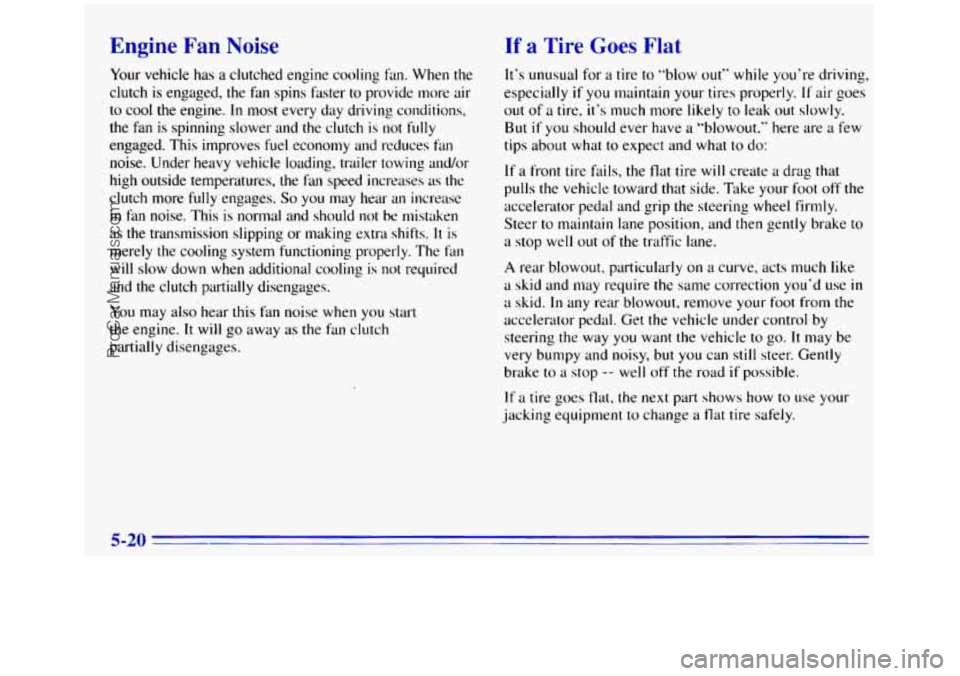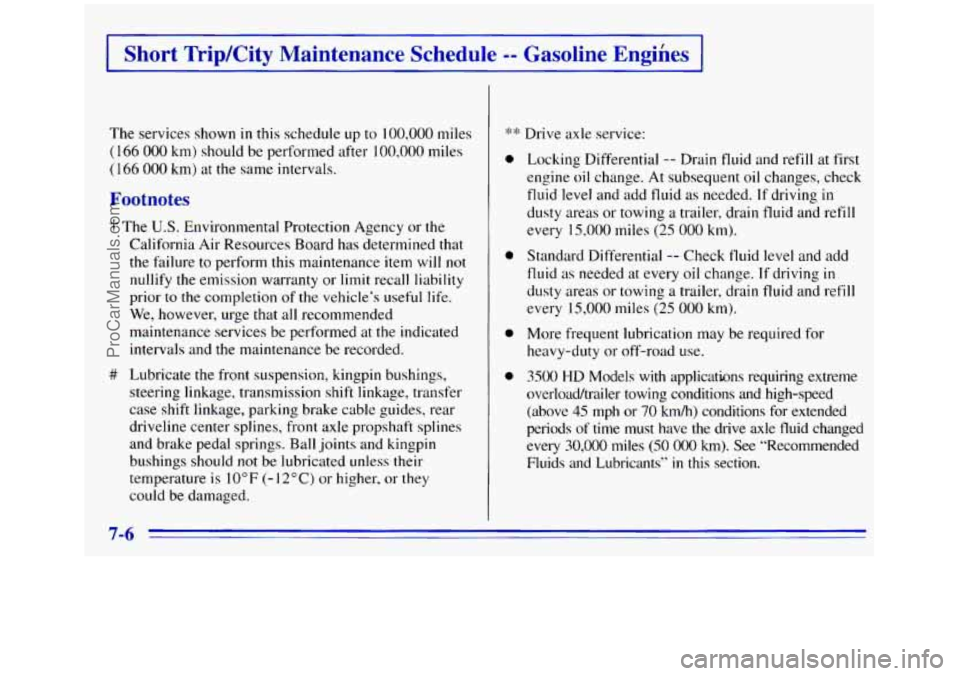Page 236 of 404

Engine Fan Noise
Your vehicle has a clutched engine cooling fan. When the
clutch
is engaged, the fan spins fdster to provide more air
to cool the engine.
In most every day driving conditions,
the fan
is spinning slower and the clutch is not fully
engaged. This improves fuel economy and reduces fan
noise. Under heavy vehicle loading, trailer towing andor
high outside temperatures, the
fm speed increases as the
clutch more fully engages.
So you may hear an increase
in fan noise. This is normal and should not be mistaken
as the transmission slipping or making extra shifts.
It is
merely the cooling system functioning properly. The fan
will slow down when additional cooling is not required
and the clutch partially disengages.
You may also hear this
fm noise when you start
the engine.
It will go away as the fan clutch
partially disengages.
If a Tire Goes Flat
It’s unusual for a tire to “blow out” while you’re driving,
especially
if you maintain your tires properly. If air goes
out
of a tire, it’s much more likely to leak out slowly.
But if you should ever have a “blowout,” here are a few
tips about what
to expect and what to do:
If a front tire fails, the flat tire will create a. drag that
pulls the vehicle toward that side. Fake your foot off the
accelerator pedal and grip the steering wheel firmly.
Steer to maintain
lane position, and then gently brake to
a stop well out of the traffic lane.
A rear blowout, particularly on a curve, acts much like
a skid and
ITMY require the same correction you’d use in
a skid. In any rear blowout, remove your foot from the
accelerator pedal. Get the vehicle under control by
steering the way you want the vehicle to
go. It may be
very bumpy and
noisy, but you can still steer. Gently
brake to a stop
-- well off the road if possible.
If a tire goes tlat, the next part shows how to use your
jacking equipment to change
a flat tire safely.
5-20
ProCarManuals.com
Page 249 of 404
Rocking your vehicle to get it out:
First. turn your steering wheel left and right. That will
clear the area around your front wheels. Then shift back
and forth between REVERSE
(R) and a forward gear (or
with a manual transmission, between FIRST (1) or
SECOND (2) and REVERSE(R)), spinning the wheels
as little as possible. Release the accelerator pedal while
you
shift. and press lightly on the accelerator pedal
when the transmission is
in gear. If that doesn't get you
out after a few tries. you nlay need to be towed out. Or,
you
can use your recovery hooks if your vehicle has
them.
If you do need.to be towed out, see "Towing Your
Vehicle" in the Index.
Using the Recovery Hooks
ProCarManuals.com
Page 259 of 404
A. Battery
B. Air Cleaner
C. Radiator Cap
D. Coolant Recovery Tmk
E. Air Filter Restriction Indicator
E Engine Oil Dipstick
G. Automatic Transmission Dipstick
H. Fan
I. Power Steering Fluid Reservoir
J. Engine Oil Fill
K. Brake Fluid Reservoir
L. Windshield Washer Fluid Reservoir
M. FuseIRelay Center
N. Storage Compartment
ProCarManuals.com
Page 260 of 404
“VORTEC” 7400 Engine
I
A. Battery
B. Coolant Recovery Tank
C. Air Cleaner
D. Radiator Cap
E. Air Filter Restriction Indicator
E Engine Oil Dipstick K. Brake Fluid Reservoir
G. Automatic Transmission Dipstick L. Storage Compartment
H. Engine Oil Fill M. Windshield Washer
I. Fan Fluid
Reservoir
J. Power Steering Fluid Reservoir Ne Fuse/RelaY Center
ProCarManuals.com
Page 281 of 404

Power Steering Fluid
When to Check Power Steering Fluid
It is not necessary to regularly check power steering
fluid unless
you suspect there is a leak in the system or
you hear an unusual noise. A fluid loss in this system
could indicate
a problem. Have the system inspected
and repaired.
How To Check Power Steering Fluid
When the engine cotnparttnent is cool, unscrew the cap
and
wipe the dipstick with a clean rag. Replace the cap
and completely tighten
it. Then remove the cap again
and
look at the fluid level on the dipstick.
The level should he at the FULL COLD mark. If
necessary, add only enough fluid to bring the level up
to the mark.
What to Use
Refer to the Maintenance Schedule to determine what
kind
of fluid to use. See “Recommended Fluids and
Lubricants” in the Index. Always use the proper fluid.
Failure to
use the proper fluid can cause leaks and
damage hoses and seals.
Windshield Washer Fluid
What to Use
When you need windshield washer fluid, be sure to read
the manufacturer’s instructions before use. If you will be
operating
your vehicle in an area where the tetnperature
may
fill1 below freezing, use a fluid that has sufficient
protection against freezing.
6-3 1
ProCarManuals.com
Page 332 of 404

Short TripKity Maintenance Schedule -- Gasoline Engines
The services shown in this schedule up to 100,000 miles
(1 66 000 km) should be performed after 100,000 miles
(166 000 km) at the same intervals.
Footnotes
T The U.S. Environmental Protection Agency or the
California Air Resources Board has determined that
the failure to perform this maintenance item will
not
nullify the emission warranty or limit recall liability
prior
to the completion of the vehicle‘s useful life.
We, however, urge that all recommended
maintenance services be performed at the indicated
intervals and the maintenance be recorded.
# Lubricate the front suspension, kingpin bushings,
steering linkage, transmission shift linkage, transfer
case shift linkage, parking brake cable guides, rear
driveline center splines, front axle propshaft splines
and brake pedal springs. Ball joints and kingpin
bushings should not be lubricated unless their
temperature is 10°F
(- 12°C) or higher, or they
could be damaged.
:f: :1:
0
0
0
e
Drive axle service:
Locking Differential
-- Drain fluid and refill at first
engine
oil change. At subsequent oil changes, check
fluid level and add fluid as needed. If driving in
dusty areas or towing a trailer, drain fluid and refill
every 15,000 miles
(25 000 km).
Standard Differential -- Check fluid level and add
fluid
as needed at every oil change. If driving in
dusty areas or towing a trailer, drain fluid and refill
every
I5,OOO miles (25 000 km).
More frequent lubrication may be required for
heavy-duty or off-road
use.
3500 HD Models with applications requiring extreme
overload/trailer towing conditions and high-speed
(above
45 mph or 70 kmh) conditions for extended
periods
of time must have the drive axle fluid changed
evey
30,000 miles (50 000 km). See “Recommended
Fluids and Lubricants’’
in this section.
7-6
ProCarManuals.com
Page 355 of 404

Long Tripmighway Maintenance Schedule -- Gasoline Engines I
The services shown in this schedule up to 100,000 miles
(1 66 000 km) should be performed after 100,000 miles
(166 000 km) at the same intervals.
Footnotes
j- The U.S. Environmental Protection Agency or the
California Air Resources Board has determined that
the failure
to perform this maintenance item will not
nullify the emission warranty or limit recall liability
prior
to the completion of the vehicle’s useful life.
We, however, urge that all recommended
maintenance services be performed at
the indicated
intervals and the maintenance be recorded.
# Lubricate the front suspension, kingpin bushings,
steering linkage, transmission shift linkage, transfer
case shift linkage, parking brake cable guides, rear
driveline center splines, front axle propshaft splines
and brake pedal springs. Ball joints and kingpin
bushings should not be lubricated unless their
temperature is
10°F (- 12°C) or higher, or they
could be damaged.
‘k‘k Drive axle service:
a
e
e
a
Locking Differential -- Drain fluid and refill at first
engine
oil change. At subsequent oil changes, check
fluid level and add fluid as needed.
If driving in
dusty areas or towing a trailer, drain fluid and refill
every 15,000 miles
(25 000.km).
Standard Differential
-- Check fluid level and add
fluid
as needed at every engine oil change. If driving
in dusty areas or towing a trailer, drain fluid and
refill every
15,000 miles (25 000 km).
More frequent lubrication may be required for
heavy-duty or off-road use.
3500 HD Models with applications requiring extreme
overloadtrailer towing conditions and high-speed
(above
45 mph or 70 kmh) conditions for extended
periods
of time must have the drive axle fluid changed
every
30,000 miles (50 000 km). See ”Recommended
Fluids and Lubricants”
in this section.
I
ProCarManuals.com
Page 371 of 404

Steering Column Lock Check
While parked, and with
the parking brake set, try to turn
the key
to LOCK in each shift lever position.
With an automatic transmission, the key should turn
With a manual transmission, the key should turn
to LOCK only when the shift lever is in PARK (P).
to LOCK only when the shift lever is in
REVERSE
(R).
On vehicles with a key release button, try to turn the key
to LOCK without pressing the button. The key should
turn to LOCK
only when you press the key button.
On all vehicles, the key should come out
only in LOCK. Parking Brake and Automatic Transmission
PARK
(P) Mechanism Check
I CAUTION:
When
you are doing this check, your vehicle
could begin to move.
You or others could be
injured and property could be damaged.
Make
sure there is room in front of your vehicle in case
it begins to roll. Be ready to apply the regular
brake at once should the vehicle begin to move.
Park
on a fairly steep hill, with the vehicle facing
downhill. Keeping your foot
on the regular brake, set
the parking brake.
0 To check the parking brake: With the engine running
and transmission in NEUTRAL
(N), slowly remove
foot pressure from the regular brake pedal.
Do this
until the vehicle
is held by the parking brake only.
To check the PARK (P) mechanism’s holding ability:
With the engine running, shift
to PARK (P). Then
release all brakes.
7-45
--- -
ProCarManuals.com